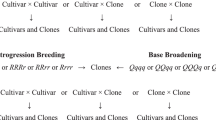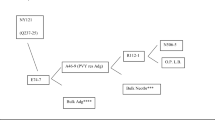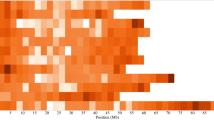Summary
The Andean farmer conserves and maintains the existing genetic diversity of potato cultivars by means of clonal propagation of tubers. However, surveys of traditional farms showed that botanical seed propagation was used for disease elimination, stock rejuvenation and the creation of new cultivars. Electrophoretic surveys based on 542 tubers collected from 18 markets sampled in the Cusco area disclosed a total of 229 different cultivars from diploid, triploid and tetraploid forms of Solanum tuberosum L. These could be classified by isozyme cluster analysis into four major groups and six minor groups. However, they did not agree with groups based on flesh or skin color. It is therefore concluded that all genotypes belong to a single, large gene pool with considerable gene flow between cultivars of different groups. When the samples were grouped by the three most common tuber skin colors, namely red/pink (‘Q'ompis type’), purple (‘Yana Imilla’ type), and yellowish/brown (‘Yuraq Kusi’ type), similar allozymes were observed in all three classes. The structure of the isozymic phenotypes within each group indicate that they may have been derived as segregants after outcrossing of diverse parental types. In order to provide further evidence for the origin of new types by hybridization, two segregating diploid progenies were generated by crossing purple by yellow skin types. In the resulting F1, most of the tuber phenotypes observed in the Andean varieties were reproduced in these crosses. It can be concluded that the Andean potatoes form a large and plastic gene pool amplified and renovated by outcrossing followed in some cases by human selection of desirable phenotypes.
Similar content being viewed by others
References
Brush, S.B., H.J. Carney & Z. Huaman, 1981. Dynamics of Andean potato agriculture. Econ. Bot. 35: 70–88.
DeJong, H., 1987. Inheritance of pigmented tuber flesh in cultivated diploid potatoes. Amer. Pot. J. 64: 338–343.
Dodds, K.S. & D.H. Long, 1955. The inheritance of colour in diploid potatoes I. Types of anthocyanin and their genetic loci. J. Genet. 54: 27–41.
Dodds, K.S., 1962. Classification of cultivated potatoes. In: D.J. Cornell (Ed.). The Potato and Its Wild Relatives. Renner, Texas: Texas Research Foundation.
Douches, D.S. & C.F. Quiros, 1987. Use of 4x–2x crosses to determine gene-centromere map distances of isozyme loci in Solanum species. Genome 29: 519–527.
Hawkes, J.G., 1990. The potato. Evolution, Biodiversity and Genetic Resources. Belhaven Press, London.
Howard, H.W., 1970. Genetics of the potato, Solanum tuberosum. Springer-Verlag.
Jackson, M.T., J.G. Hawkes & P.R. Rowe, 1977. The nature of Solanum × chanca Juz et Buk., a triploid cultivated potato of the South American Andes. Euphytica 26: 775–783.
Jackson, M.T., J.G. Hawkes & P.R. Rowe, 1980. An ethnobotanical field study of primitive potato varieties in Peru. Euphytica 29: 107–113.
Johns, T. & S.L. Keen, 1986. Ongoing evolution of the potato on the Altiplano of Western Bolivia. Econ. Bot. 40: 409–424.
Malagamba, P. & A. Monares, 1988. True Potato Seed: Past and Present Uses. International Potato Center, Lima, Peru.
Pallais, N. 1991., True potato seed: Changing potato propagation from vegetative to sexual. Hort. Sci. 26: 239–241.
Quiros C.F., S.B. Brush, D.S. Douches, K.S. Zimmerer & G. Huestis, 1990. Biochemical and folk assessment of visibility of Andean cultivated potatoes. Econ. Bot. 44: 254–266.
Quiros, C.F. & N. McHale, 1985. Genetic analysis of isozyme variants in diploid and tetraploid potatoes. Genetics 111: 131–145.
Rabinowitz, D., C.R. Linder, R. Ortega, D. Begazo, H. Murguia, D.S. Douches & C.F. Quiros, 1990. High levels of interspecific hybridization between Solanum sparspilum and S. stenotomum in experimental plots in the Andes. Amer. Pot. J. 67: 73–81.
Raamsdonk, L.W.D. van, 1988. IRIS: computer package for information regrouping to identify structures. Wageningen, The Netherlands.
Author information
Authors and Affiliations
Rights and permissions
About this article
Cite this article
Quiros, C., Ortega, R., van Raamsdonk, L. et al. Increase of potato genetic resources in their center of diversity: the role of natural outcrossing and selection by the Andean farmer. Genet Resour Crop Evol 39, 107–113 (1992). https://doi.org/10.1007/BF00051229
Received:
Accepted:
Issue Date:
DOI: https://doi.org/10.1007/BF00051229




